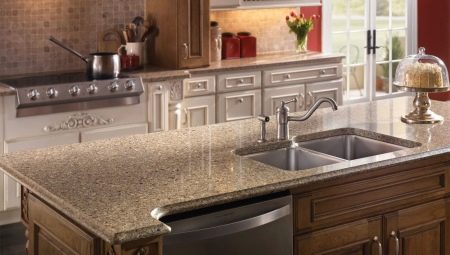Stone countertops for the kitchen are a practical solution that can provide durability and aesthetics for the work surfaces used here. Natural minerals and rocks are highly durable, have the longest possible life, and have a unique external appearance. Even in one array, slabs - carved stone slabs, will have an absolutely unique pattern. There are also their artificial analogues from quartz agglomerate and other composite materials. They are more affordable, have properties similar to those of natural minerals, and fit well into the interior of the kitchen.
Stone countertops made of natural granite, marble and other models look really attractive, respectable, immediately bring an element of luxury to the decor. They combine well with modern interior solutions, and with classic kitchen design options. But stone countertops have their own characteristics, which are worth considering when choosing.
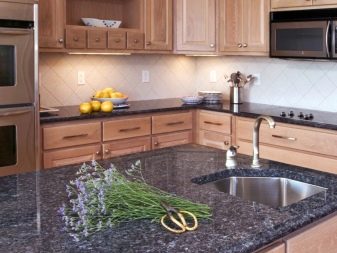
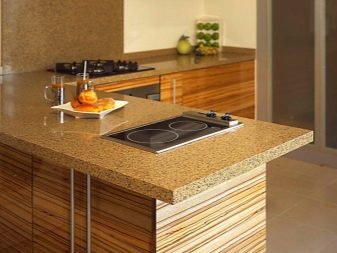

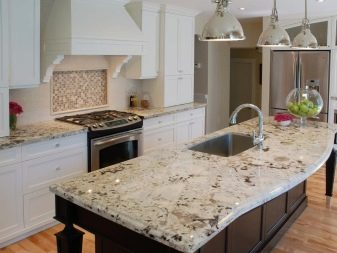
Advantages and disadvantages
Stone countertops made of natural mineral for the kitchen are considered the best choice for a country house, a spacious apartment with a free layout. It is worth noting a few obvious advantages.
- Long service life. Natural stone is practically not subject to abrasion. When chips are formed, the defect can be sanded, making it invisible. A standard stone countertop will last at least 20 years.
- High mechanical strength. A plate made of natural stone is difficult to damage, scratch.Some types of stone are distinguished by a certain complexity in processing, which limits the choice of decorative solutions.
- Aesthetics. The beauty of natural stone is unique, there are many options for colors, shades created by nature itself. Different breeds have their own characteristics of texture and structure, polishing can achieve a glossy shine.
- Universality. Both natural and artificial stone have no restrictions on the location of open fire sources, heating appliances. It does not absorb moisture, odors, can act as a work surface or dining tabletop.
- Natural origin, environmental cleanliness. The stone does not emit harmful substances, hypoallergenic, completely safe for humans.
- Easy to clean, maintain order. The stone does not attract dust, since it lacks electrostaticity. The surface is easy to clean from dirt, in most cases you can use abrasive cleaners.

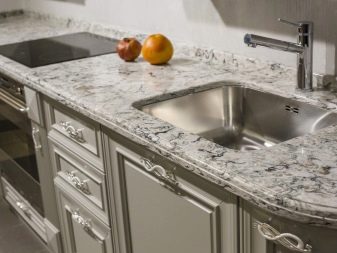
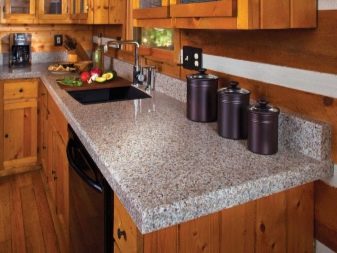

They have stone countertops for the kitchen and their drawbacks. The massiveness of such structures can be attributed to them - the base for them must be very strong, chipboard or other plates will definitely not fit. Besides, a thick stone slab may look too massive in a small area. The disadvantages include difficulties in cutting the material. The stone requires precise and professional cutting; it cannot be carried out with ordinary home tools. The surface of such a countertop always remains cold, which can also cause some discomfort. To preserve the properties of minerals, they must be periodically treated with specialized compounds that prevent the penetration of dirt and moisture deep into the pores, and this also requires effort and cost.
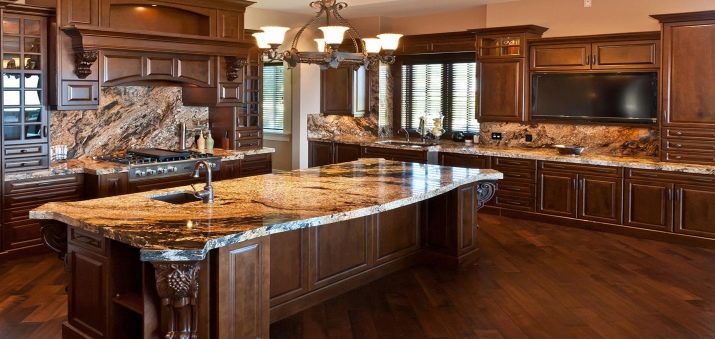
Overview of the types of stone
In nature, there are rocks and minerals that differ in their properties and characteristics. Not all of them are suitable for the manufacture of large-scale products, which include countertops. Kitchen worktops, bar counters, carved from a single slab - one large plate, must have strength and functionality. Layered minerals, even the most beautiful, porous and soft stones, are not suitable for use as tabletops, they require additional processing.
But there are breeds considered the optimal solution for such purposes.
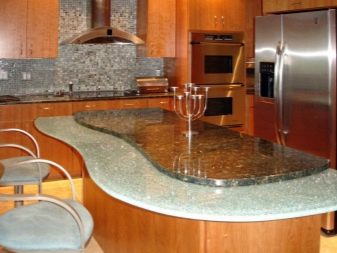
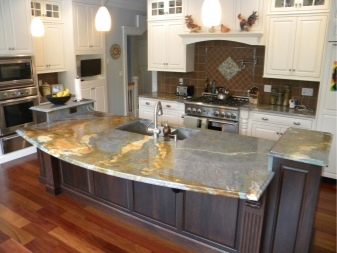
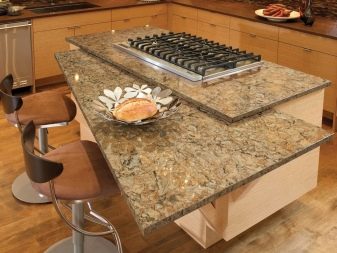
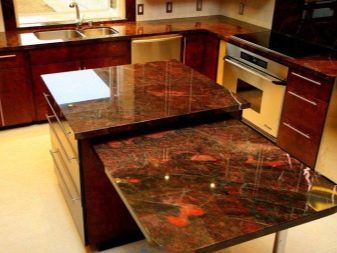
Granite
The most durable countertop for the kitchen is granite. This rock is not “noble” like marble or travertine, but is very popular. Its deposits are located all over the world, including in Russia. For use in the interior are suitable types of stone belonging to the I class of radioactivity, completely safe for human health.
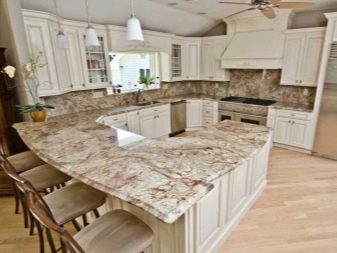
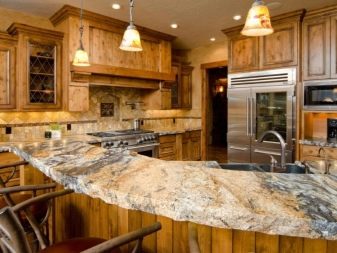
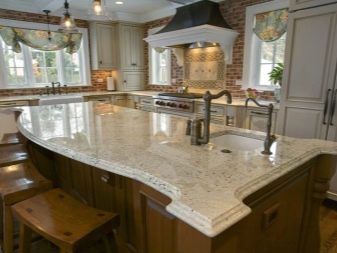
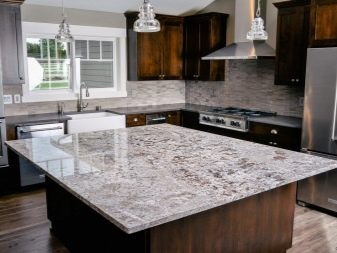
Granite countertops can withstand the most intensive use, they are used in professional restaurant kitchens, where the sanitary and hygienic requirements for the materials used are especially high. The choice in favor of this version of the stone is usually associated with its durability and resistance to wear. Besides, granite does not absorb moisture after polishing, it looks quite impressive.
The rich color scheme of the stone is presented mainly in dark colors.
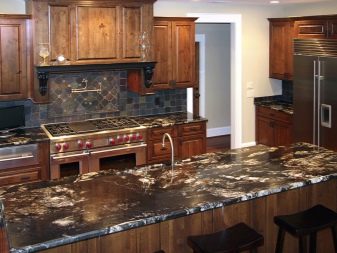

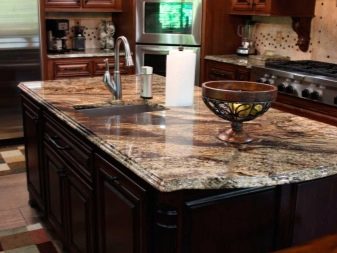
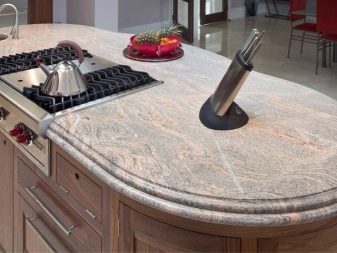
When installing granite countertops of large length or complex shape, it is necessary to make connecting seams. Due to its hardness, the stone is worse than others in processing, it is impossible to make complex figured products. Another of its peculiarities is that during destruction it will not be possible to restore the slab. In addition, the massiveness of granite requires the most solid foundation - most often it is installed on metal supports in order to reduce the load directly on the headset itself. It is worth paying attention to the fact that unpolished granite easily absorbs moisture and needs additional processing.

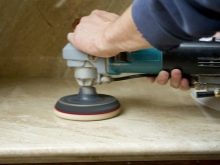
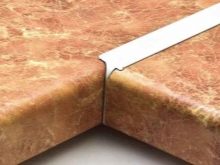
Marble
A luxurious marble countertop looks spectacular, but is usually used in the kitchen as an element of the covering of the bar counter or in the sink area. The high porosity of the material, combined with its softness, instability to temperature extremes complicates the creation of such a coating in the working area. Marble absorbs dirt, odors, can quickly lose its beauty in contact with acids. But all these points do not cancel the luxurious texture of this stone, the variety of its colors, the uniqueness of the picture on the cut. Marble is considered one of the most beautiful minerals. It is easy to restore, polished and sanded. You can find a countertop made in a modern style, in ancient traditions. But this material is quite expensive, requires careful handling.
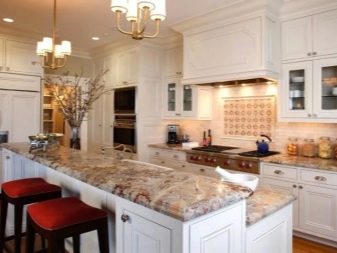
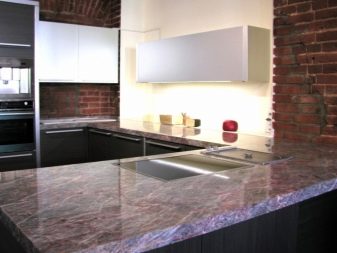
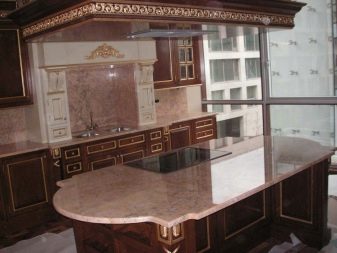
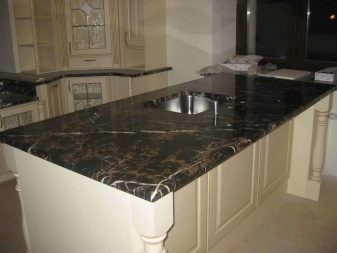
Travertine
Travertine is a relatively mild mineral. This type of calcareous tuff is called immature marble. He really bears a great resemblance to this stone, but less demanding to care for. Travertine countertops can be washed with conventional chemicals, but they are afraid of acid exposure and absorb smoke odors. The stone has a rough texture, lends itself well to machining. If necessary, it can be sanded again, restored.
Travertine for countertops mainly has a light yellow color with a small number of stripes and veins. For softer tuff, the gamma of shades is more diverse - from brown to white.
Among the advantages of travertine can be noted non-slip surface texture, noble appearance, affordable cost.
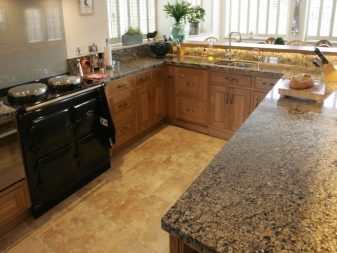
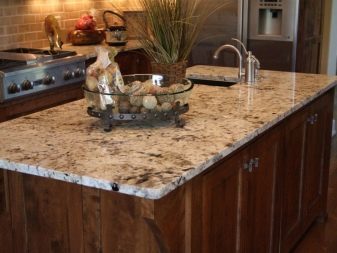

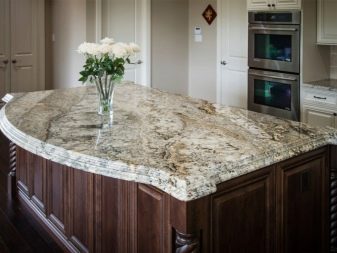
Gabbro
This black variety of granite is distinguished by its magnificent external appearance, it is rightfully recognized as one of the best options for the manufacture of kitchen worktops. When polished, it acquires a mirror shine with a slight flickering effect. Such a luxurious addition will suit both a high-tech headset and a classic style. The surface of the stone is not subject to abrasion, it is safe to put hot pots and pans on it, you can cut meat, instantly eliminate any traces of culinary experiments. On the surface of the gabbro, you do not need to apply special protective compounds. The stone has an extremely low water absorption, resistant to acids and alkalis.
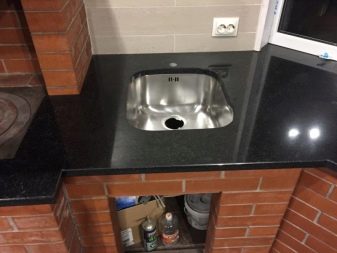
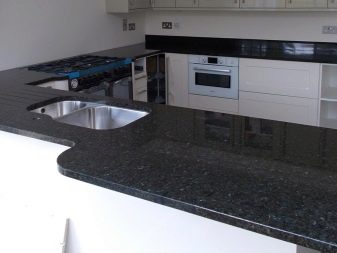
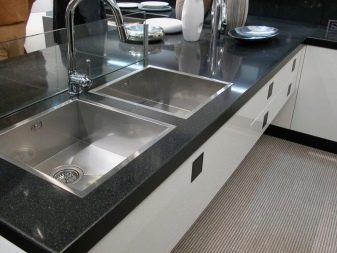

Onyx
This beautiful stone with a translucent structure is considered ornamental. It can be used for the manufacture of countertops in expensive interior design. Its unusualness is multilayered - thin on strips of different colors, alternating each other, are located inside the onyx. The main background is most often brown, with white and black inclusions. In white onyx, the stripes are pink and yellow. It looks especially impressive with backlighting from below.

Onyx countertops are a rare occurrence, but this is not due to its low popularity. This soft natural material is not very resistant to chemical attack. And to get a large array of semi-precious stone is quite difficult, usually smaller items are made from it. This worktop is perfect for use outside the work area - as a bar counter.
Onyx is not afraid of heating, resistant to moisture absorption, exposure to sunlight.
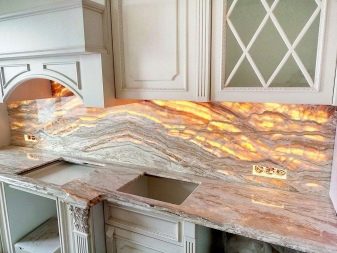
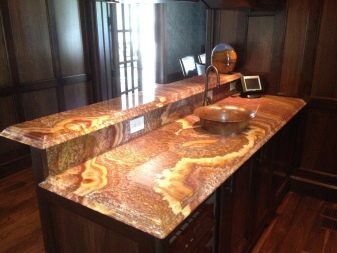
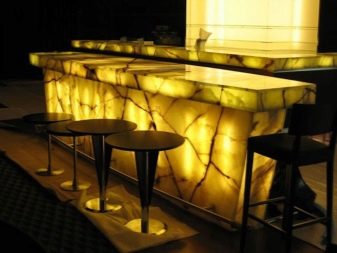
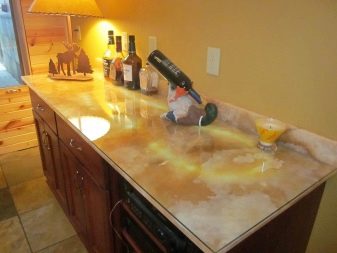
Basalt
Basalt countertops are not common, but this rock as a material really deserves the closest attention. For the manufacture of flat large-format products, stone types with the most dense structure are used. The colors are dominated by dark tones interspersed with gray, yellow-green colors. Basalt countertops are as durable as granite, able to maintain their best qualities for up to 50 years, support seamless installation.
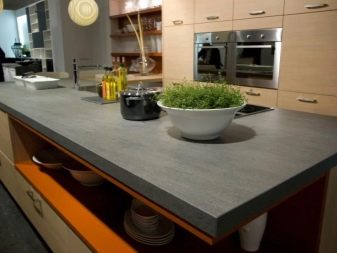

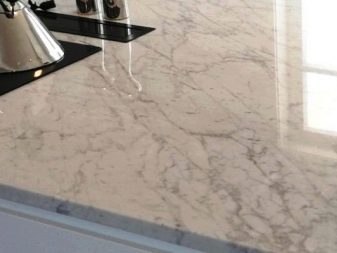
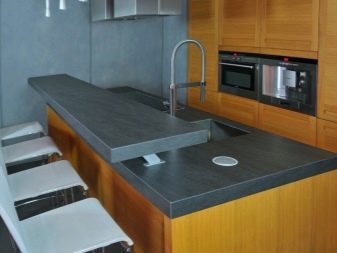
Dimensions
Stone countertops are always made to order, based on the individual characteristics of the headset.At the same time, the standard slab, a plate of natural mineral, has dimensions of 2x3 m - this is an international standard. If other parameters are needed, the countertop will have to be made compound by connecting the joints by fitting and processing with special compounds. The shape of the manufactured item may be rectangular or oval.
Almost always, you can make a curved edge design, round it, or select a chamfer.

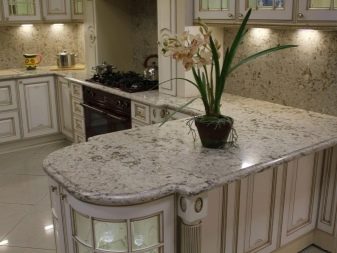
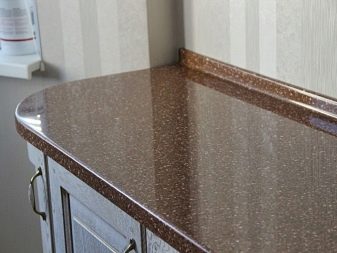
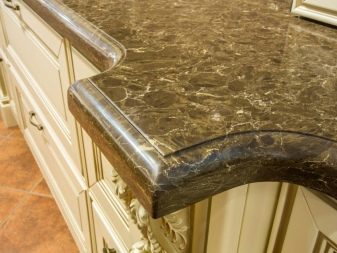
The thickness of a standard countertop does not exceed 40 mm. If you want to make it more massive, several layers are joined together. For example, if a cooktop is to be built into the product, it is better to give preference to a massive version of at least 60 mm thick. A thinner countertop can simply collapse around the edges. For marble and travertine, the standard thickness of the working surface of the headset is 25-30 mm. Granite products are made in the range of 30-50 mm.
Design options
To decide on the design of stone countertops for the kitchen, it is enough to take into account a number of simple points.
- The white design blends well with bright or contrasting details. A dark sink and hob, a bright apron - this will be enough to emphasize its impeccability.
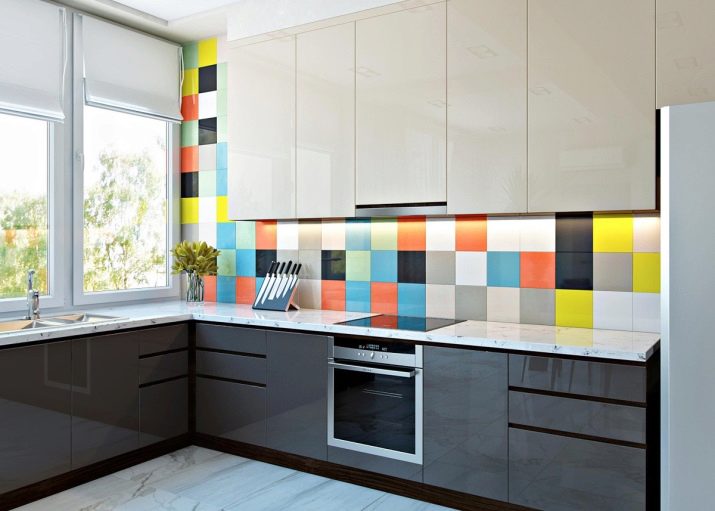
- Unusual colors are best used on freestanding or attached surfaces. The turquoise, yellow, green bar counter or countertop of the island kitchen looks spectacular, becoming the central element of the composition.
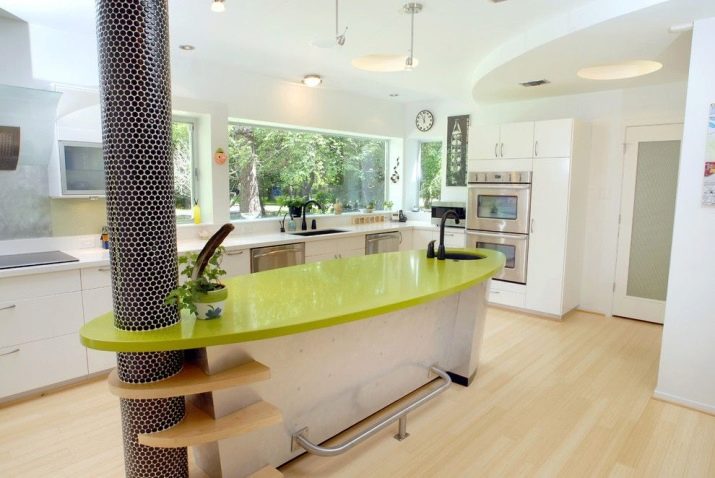
- A gray marble or granite panel is an excellent solution for a modern kitchen. Glossy countertops fit into a minimalist interior. A matte model will decorate a loft or chalet.

- Neutral beige shade goes well with natural wood. This worktop is easy to fit into a classic interior, country style.
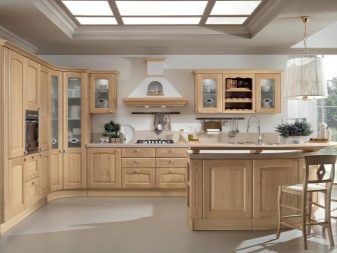
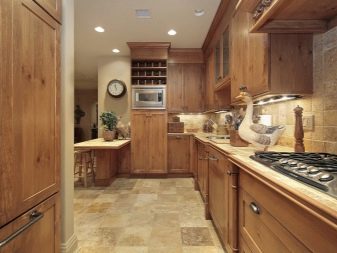
- Gloss black glossy mirror is the perfect solution for a stylish kitchen in red or white. A polished gabbro worktop option is a good fit here.

Selection tips
When choosing a countertop for a kitchen made of natural stone, it is imperative to pay attention to the correspondence of the remaining elements of the interior to its appearance and characteristics. So, for a headset from chipboard, it is better to choose a more affordable option. Natural stone weighs a lot, a wood slab simply can not withstand its massiveness. If you plan to combine a countertop with a sink, you can give preference to softer rocks - marble or travertine. For a hob with a gas or electric heater, it is better to purchase a granite or basalt version.
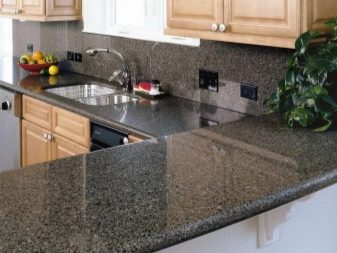
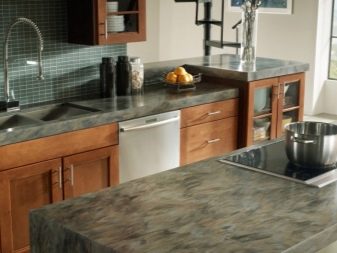
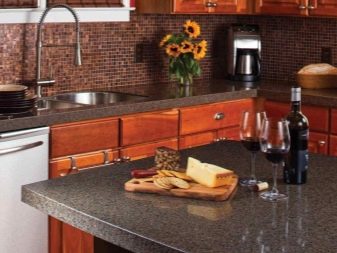
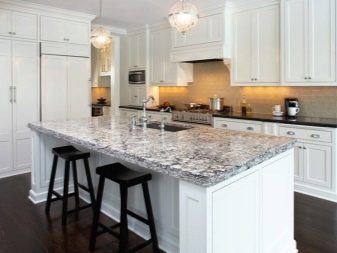
If you plan to harmoniously connect the countertop with an apron, you should think about the commonality of textures. The glossy finish on the wall blends in better with the polished polished stone. Matte plaster or panels are combined with marble, travertine. Before choosing a stone, it is worth seeing it, assessing the real compliance of the slab color with expectations. If you want to get a countertop cheaper, you can consider options in which each floor cabinet will have a separate top. An integral design is more complicated and expensive to produce. In addition, if there are joints in it, they will be more vulnerable to stress than whole sections.
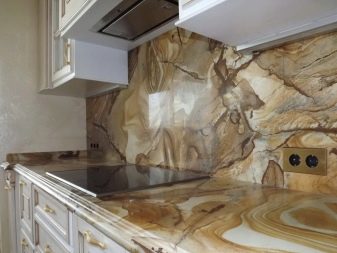
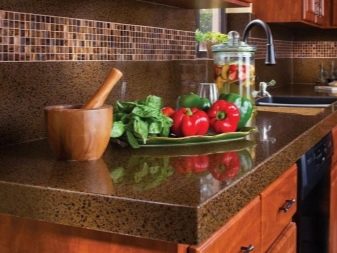
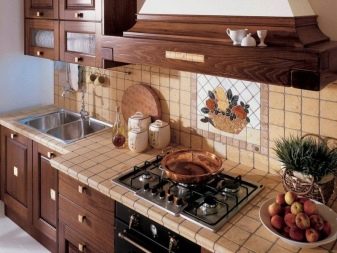
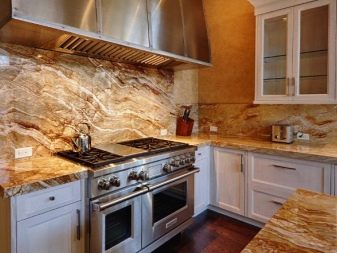
Installation
The process of installing finished stone countertops goes as follows:
- pre-made product is tried on; the surface is displayed according to the level, if necessary, compensating differences in the height of the gasket are used;
- if it is necessary to incorporate additional elements, a hole for them is cut out with a grinder;
- masking tape is applied to the ends at the seam site;
- the countertop is mounted on a support inside and out, fixed in place with screws and sealant; all seams are masked with a tinted surface of epoxy glue;
- if necessary, grinding is carried out after hardening of all compositions; traces of epoxy glue are cleaned with denatured alcohol;
- a wall decorative skirting board is installed, closing the gap between the wall and the headset; the countertop is ready for use.
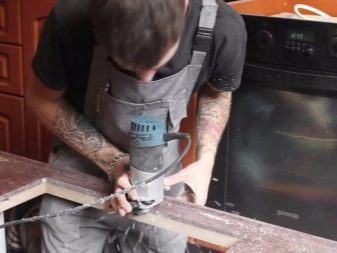


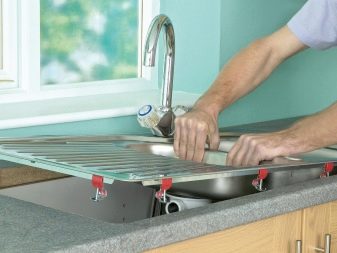
Beautiful examples
A spectacular tabletop made of black polished marble smoothly passes into the kitchen apron. This is the best solution for a spacious kitchen.
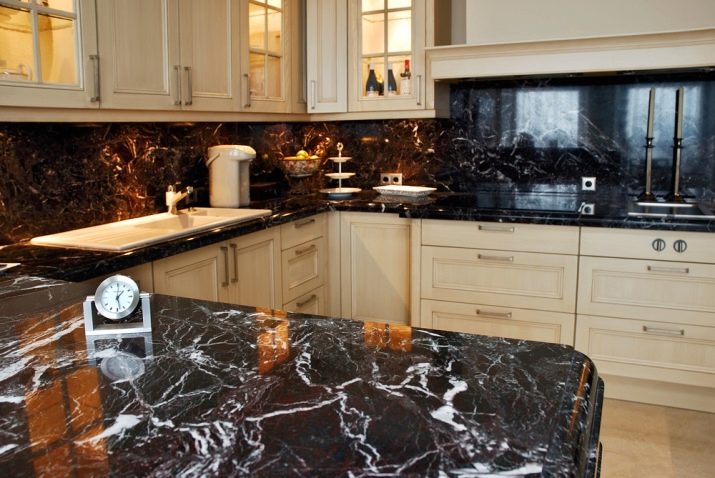
Stylish tabletop made of onyx. The backlight looks especially spectacular at night and in the evening.
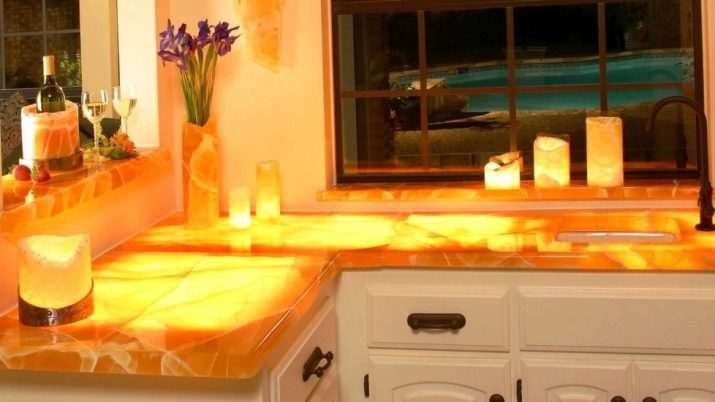
Luxurious travertine countertop in a Mediterranean-style kitchen. The rough texture of the stone is preserved and highlighted to create an authentic interior.
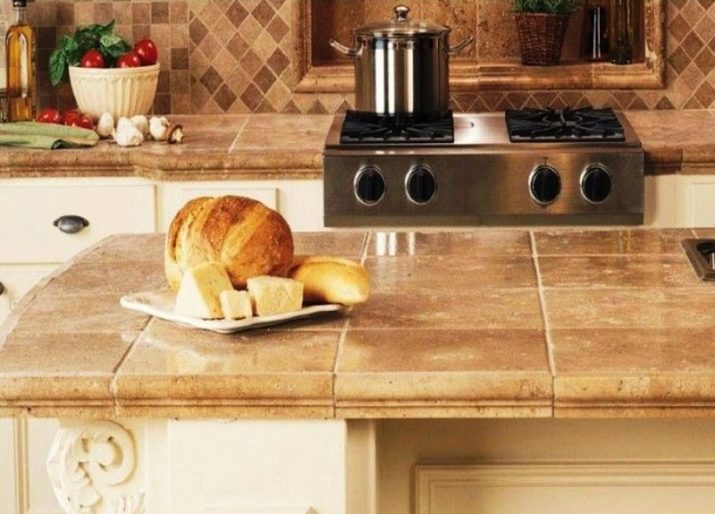
See how to choose the right stone worktop for the kitchen in the next video.
